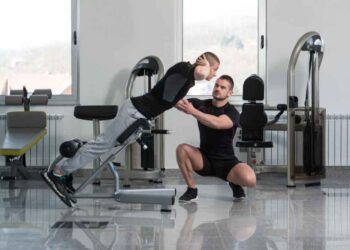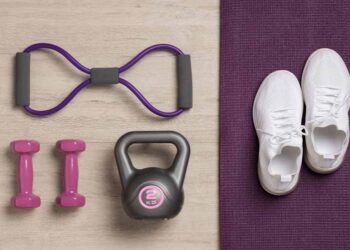When it comes to building strong and sculpted hamstrings, many people turn to traditional exercises like squats and lunges. But what if there was a powerful exercise that specifically targets and strengthens these muscles, giving you the defined legs you’ve always wanted?
Enter leg curls – the secret weapon for achieving sculpted hamstrings! These exercises, including lying, seated, and standing variations, are not only highly effective but also offer a range of benefits that can take your leg workout to the next level.
So, why exactly are leg curls so effective and why should you incorporate them into your leg routine? Let’s dive in and explore the amazing world of leg curls, from their techniques and variations to their undeniable benefits for your leg strength and overall athletic performance.
Key Takeaways:
- Leg curls are highly effective exercises for sculpting and strengthening the hamstrings.
- They target specific muscles in the legs that play a crucial role in knee flexion and hip extension.
- Leg curls enhance hamstring strength, improve athletic performance, and reduce the risk of hamstring injuries.
- There are various techniques and variations of leg curls, allowing for added variety in your leg workout routine.
- Proper form and technique are essential for performing leg curls safely and effectively.
Understanding the Benefits of Leg Curls
Leg curls offer a range of benefits for the legs, particularly the hamstrings. Scientific studies have shown that leg curls are highly effective for hamstring strengthening, with higher levels of muscle activation compared to other exercises. Strong hamstrings improve athletic performance, including speed, agility, and power.
Furthermore, leg curls play a crucial role in injury prevention by reducing the risk of hamstring injuries. By strengthening the hamstrings, these exercises make the muscles more resilient to strains and tears.
Incorporating leg curls into your leg workout routine also ensures balanced leg development. While the quadriceps often receive more attention, neglecting the hamstrings can lead to muscle imbalances and potential injury. Leg curls provide an excellent opportunity to target and strengthen the hamstrings, promoting overall leg symmetry.
Whether you’re an athlete looking to improve performance or simply striving for well-rounded leg strength, adding leg curls to your training regimen can yield significant benefits. Get ready to enhance your hamstring strength, boost athletic performance, prevent injuries, and achieve balanced leg development with the power of leg curls!
Techniques and Variations of Leg Curls
Leg curls are an essential exercise for targeting and strengthening the hamstrings. They can be performed in various ways, allowing you to add variety to your leg workout routine. Here are three common leg curl variations:
Lying Leg Curls
To perform lying leg curls, lie facedown on a leg curl machine. Position your legs under the padded bar, ensuring it rests just above your feet. With control, curl your legs upward by contracting your hamstrings. Slowly lower your legs back to the starting position, maintaining tension throughout the movement. Lying leg curls primarily target the hamstrings, helping to develop strength and definition in the muscles.
Seated Leg Curls
Seated leg curls are performed in a seated position. Start by adjusting the machine to a comfortable setting, positioning the leg pad just above your ankles. Extend your legs in front of you, grasping the handles for stability. From here, curl your legs against the resistance by contracting your hamstrings. Control the movement as you lower your legs back down. Seated leg curls isolate the hamstrings, allowing for focused muscle engagement and development.
Standing Leg Curls
If you’re looking to challenge your balance and stability, standing leg curls are an excellent option. Stand upright, holding onto a sturdy support for balance. You can use a cable machine or resistance bands for this exercise. Begin by bending one leg at the knee, bringing your heel toward your glutes while keeping your thigh stationary. Slowly return your leg to the starting position. Repeat the movement with the opposite leg. Standing leg curls not only target the hamstrings but also engage the lower back and core muscles to maintain stability.
By incorporating these leg curl variations into your leg workout routine, you can effectively target and strengthen your hamstrings from different angles. Remember to adjust the weight and resistance according to your fitness level and focus on using proper form and control throughout each repetition.
Proper Form and Technique for Leg Curls
Proper form and technique are crucial when performing leg curls to ensure effectiveness and safety. By maintaining control and focusing on the targeted muscles, you can maximize the benefits of this exercise.
There are different variations of leg curls, each requiring specific form and technique. Let’s explore the proper execution for each:
Lying Leg Curls
For lying leg curls, position your upper body on the leg curl machine with your legs extended. Engage your hamstrings as you curl your legs upward, using controlled movements to avoid relying solely on momentum. Remember to maintain a neutral spine throughout the exercise.
Seated Leg Curls
In seated leg curls, start by adjusting the leg curl machine so that your legs are extended in front of you. From this seated position, curl your legs against the resistance, focusing on contracting your hamstring muscles. Keep your back straight and avoid leaning forward or using excessive jerking motions.
Standing Leg Curls
Standing leg curls involve curling one leg at a time while standing. You can perform this exercise using a cable machine or resistance bands. Stand tall with one foot slightly in front of the other. While maintaining stability, lift your back foot off the ground and curl it towards your glutes. Control the movement throughout the range of motion and switch legs to target both hamstrings.
It’s essential to start with an appropriate weight that allows you to maintain proper form. Gradually increase the resistance as you become more proficient, ensuring you can execute the exercises with control and precision.
When performing leg curls, always prioritize safety. Here are some safety tips to consider:
- Ease into leg curls: If you’re new to leg curls, start with lighter weights and focus on mastering the technique before increasing intensity.
- Avoid sacrificing form for repetitions: It’s better to perform leg curls with perfect form and fewer repetitions than to compromise form for the sake of completing a higher number of reps.
- Seek assistance or modifications if needed: If you have any concerns about your technique or any pre-existing conditions, consult a qualified fitness professional for guidance and modifications.
By following proper form and technique and incorporating safety precautions, you can safely and effectively integrate leg curls into your leg workout routine, reaping the benefits of stronger and more sculpted hamstrings.
Conclusion
Leg curls, including lying, seated, and standing variations, are powerful exercises for sculpting and strengthening the hamstrings. These Leg Curl exercises target the biceps femoris, semitendinosus, and semimembranosus muscles, promoting leg strength and balanced leg development.
Not only do Leg Curls enhance hamstring strength, but they also have numerous benefits when it comes to athletic performance. By incorporating Leg Curl exercises into your leg workout routine, you can improve your leg strength, allowing you to run faster, jump higher, and perform better in your chosen sports or activities.
Furthermore, Leg Curls help reduce the risk of hamstring injuries, ensuring that your legs stay strong and healthy for optimal physical performance. Whether you’re a dedicated athlete or a fitness enthusiast, Leg Curls can be your secret weapon to achieving stronger, healthier legs.
Start incorporating Leg Curls into your fitness routine today and experience the remarkable benefits for yourself. Take advantage of this effective exercise to sculpt your hamstrings, boost your leg strength, and achieve the balanced leg development necessary for overall athletic performance.














